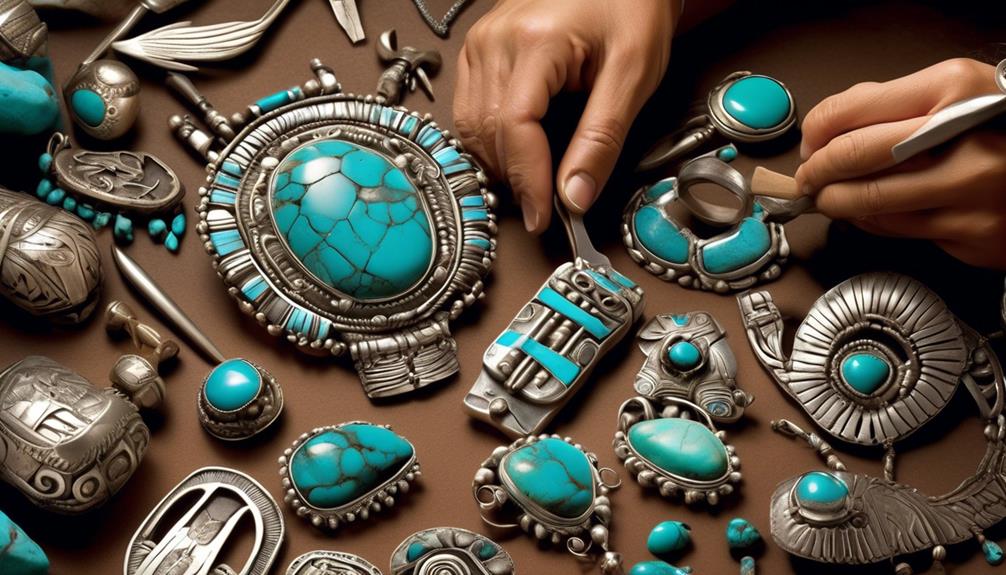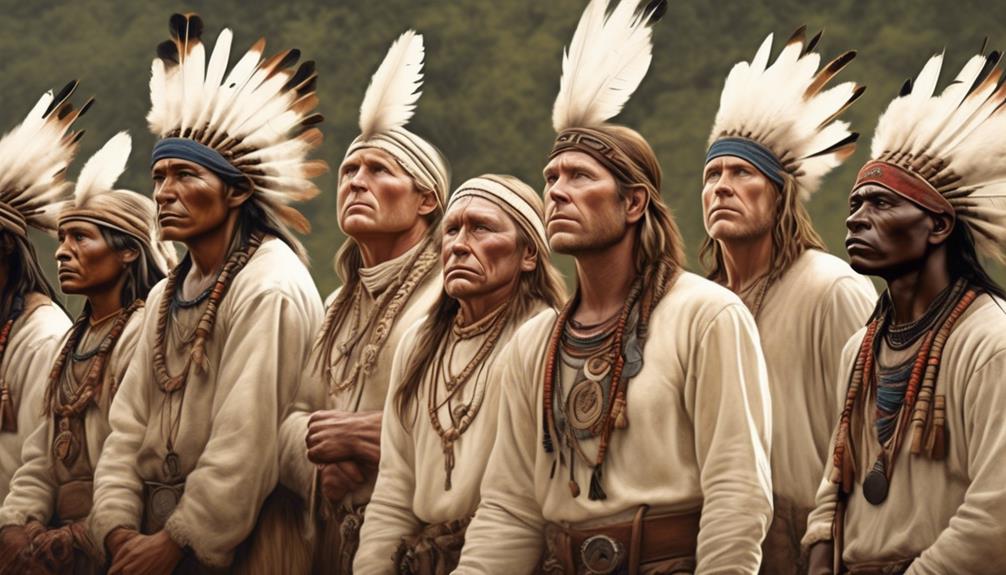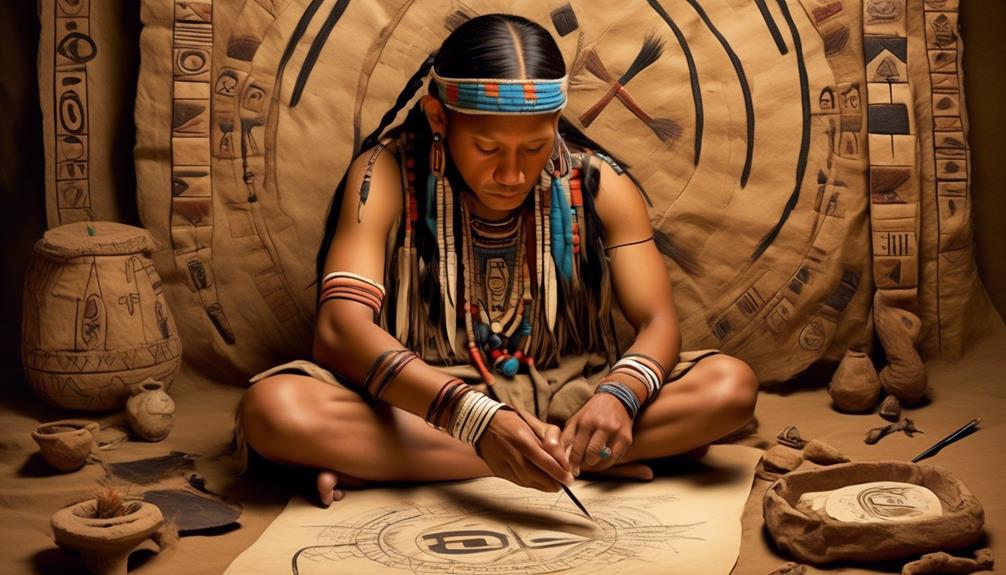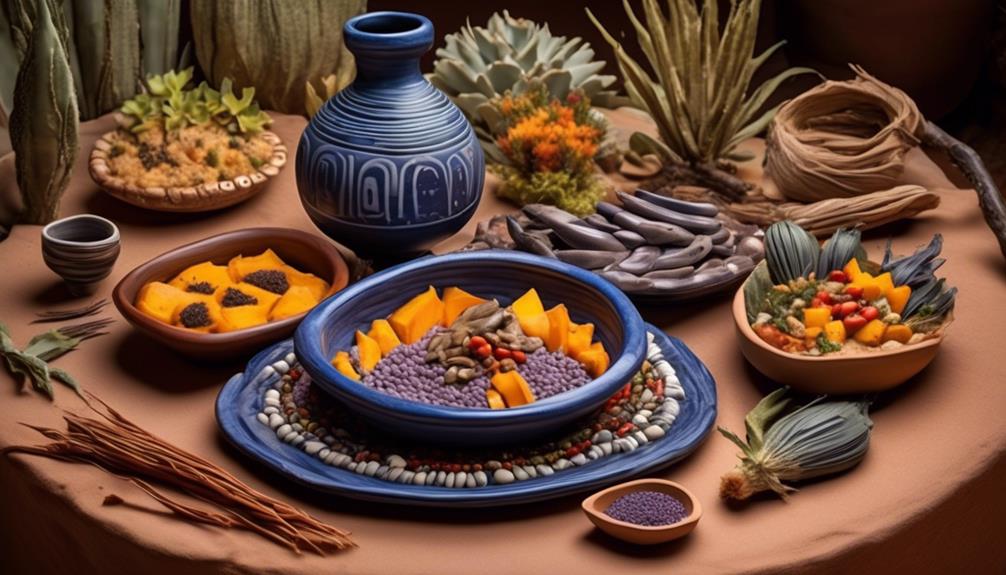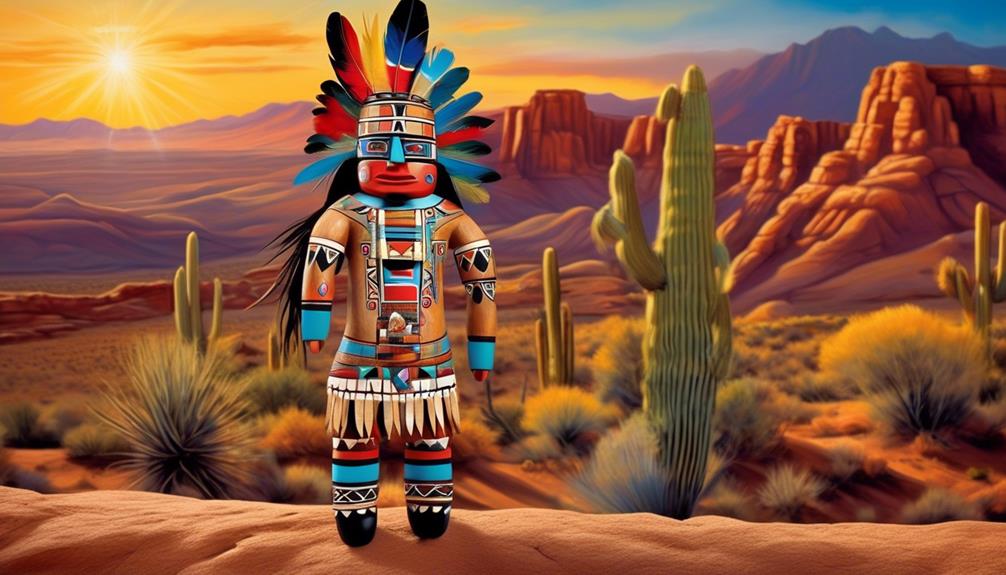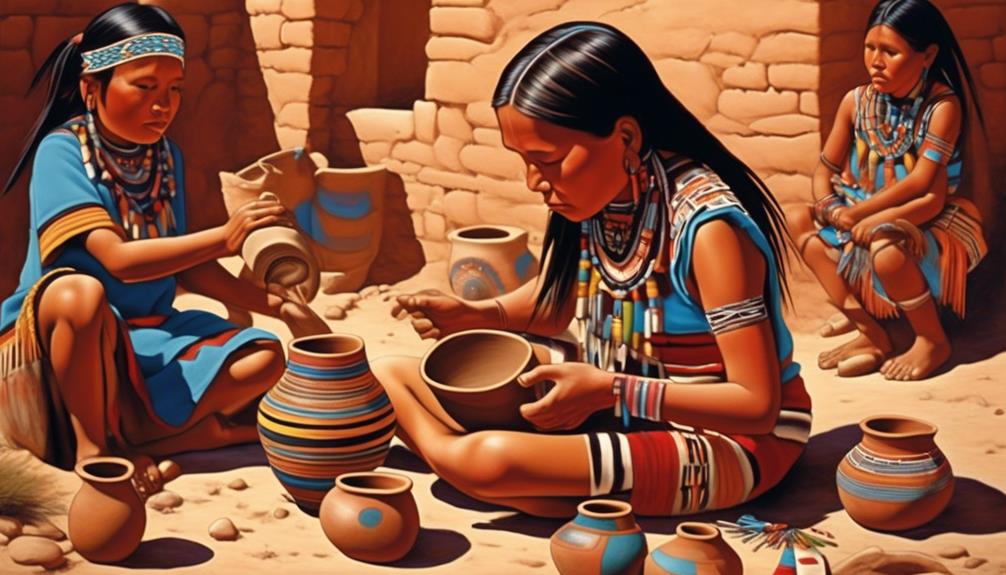Are you curious about learning how to make jewelry from the Hopi Tribe? Prepare yourself, as we are about to embark on a journey through history and culture.
For those seeking a glimpse into the rich cultural heritage of the Hopi people, understanding the symbolism and significance of their jewelry is just the beginning.
But fear not, as we delve into the intricate process of selecting authentic materials, mastering traditional techniques, and incorporating meaningful motifs, you'll soon discover the profound beauty and craftsmanship that goes into each handcrafted piece.
Join us as we uncover the secrets behind creating these timeless masterpieces that have captivated the hearts of many.
Key Takeaways
- Hopi jewelry expresses the history, spirituality, and beliefs of the Hopi people.
- Authentic materials like sterling silver, turquoise, coral, and other semi-precious stones are used in crafting Hopi jewelry.
- Traditional metalworking techniques such as overlay, tufa casting, and stampwork hold profound cultural significance in Hopi jewelry.
- Meaningful motifs and patterns in Hopi jewelry reflect cultural significance and the artistic legacy of the tribe.
Understanding the Symbolism of Hopi Jewelry
Hopi jewelry is rich in symbolism, with each intricate design and pattern holding deep cultural significance for the tribe. The jewelry serves as a visual language, expressing the history, spirituality, and beliefs of the Hopi people. Traditional designs, such as the intricate overlay technique, aren't just for aesthetic appeal but are deeply rooted in the tribe's cultural identity. Each symbol and motif tells a story, from the migration of the Hopi people to the importance of rain in their agricultural practices.
Artistic expression is a fundamental aspect of Hopi jewelry, with each piece reflecting the creativity and skill of the artisan. The use of specific symbols, such as the water wave, corn, or sunface, conveys the interconnectedness of the natural world and the Hopi way of life. The jewelry also serves as a form of personal and cultural expression, with different designs and symbols representing individual experiences and tribal affiliations.
Understanding the symbolism of Hopi jewelry goes beyond appreciating its aesthetic beauty; it requires a deep appreciation for the cultural heritage and spiritual beliefs of the Hopi tribe.
Selecting Authentic Materials for Your Designs
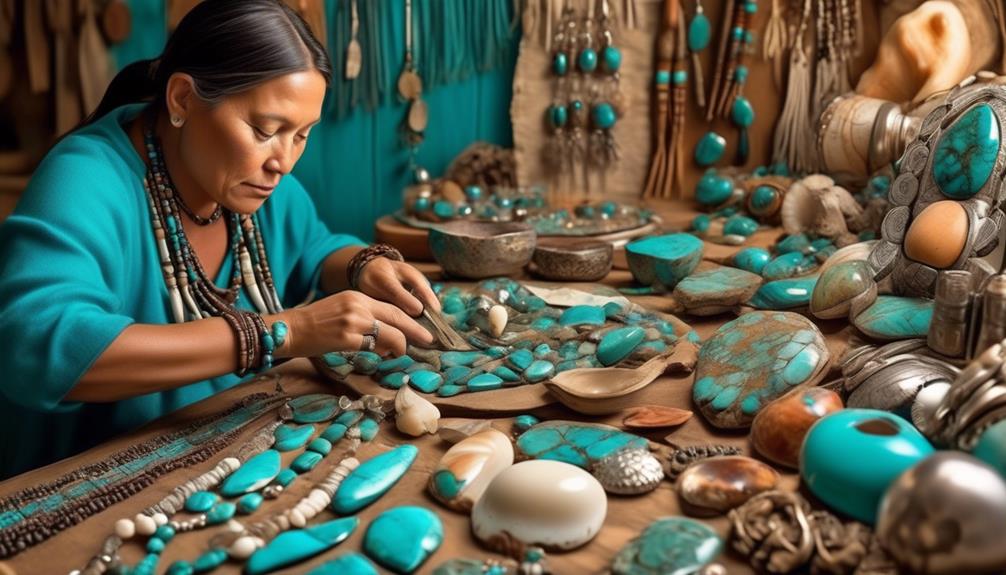
Exploring the rich symbolism of Hopi jewelry naturally leads to a consideration of the authentic materials essential for crafting these intricate designs. Sourcing materials for Hopi Tribe jewelry is a deeply cultural and symbolic process. The materials used in crafting Hopi jewelry are chosen with care, reflecting the tribe's deep connection to their traditions and the natural world.
Authentic Hopi jewelry is often crafted from materials such as sterling silver, turquoise, coral, and other semi-precious stones. Each material holds cultural significance, with turquoise symbolizing water and sky, while coral represents the earth and the interconnectedness of all living beings in Hopi tradition.
When sourcing materials for crafting Hopi jewelry, it's essential to seek out authentic and ethically-sourced materials. This not only ensures the cultural integrity of the jewelry but also respects the traditions and beliefs of the Hopi Tribe. The cultural significance of these materials goes beyond their physical attributes, as they're imbued with the stories, traditions, and spirituality of the Hopi people. Understanding and honoring these cultural significances is paramount in creating authentic Hopi Tribe jewelry.
Mastering Traditional Hopi Jewelry Techniques
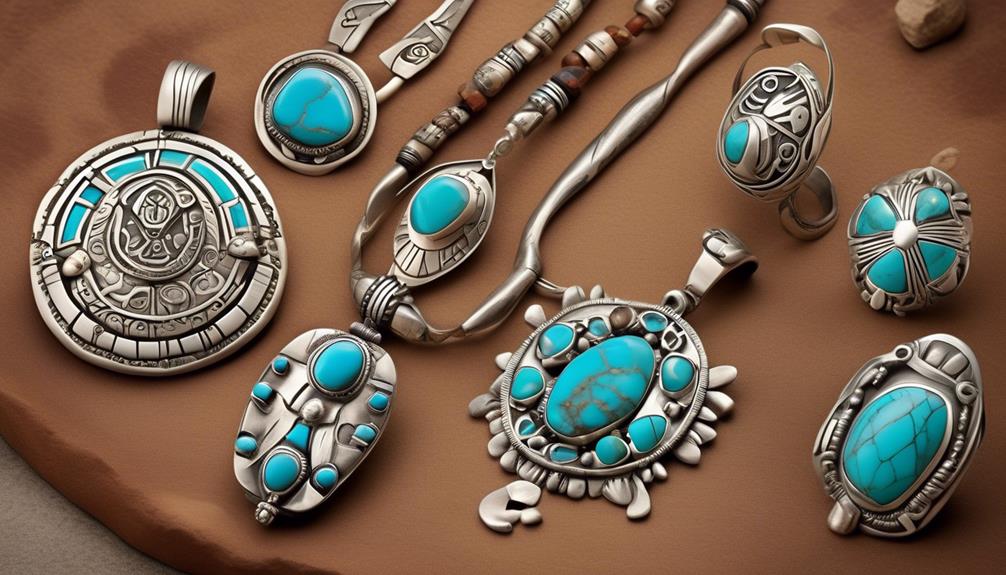
As we delve into the art of crafting traditional Hopi jewelry, it becomes apparent that mastering the intricate techniques requires a deep understanding of the tribe's cultural heritage and artistic expressions. The metalworking techniques employed in creating Hopi jewelry hold profound cultural significance, with each design inspired by the historical context of the tribe. The process of mastering traditional Hopi jewelry techniques involves a deep connection to the cultural and spiritual aspects embedded in each piece.
| Metalworking Techniques | Cultural Significance |
|---|---|
| Overlay Technique | Symbolizes balance and harmony in nature |
| Tufa Casting | Represents the relationship between the Hopi and their environment |
| Stampwork | Reflects the tribe's connection to their ancestors and traditions |
The design inspiration for Hopi jewelry is drawn from the tribe's history, beliefs, and environment. Understanding the historical context of each design allows for a more profound connection to the artistry and cultural significance behind every piece. Mastery of these techniques goes beyond skill; it requires a deep appreciation and respect for the traditions and heritage of the Hopi tribe.
Incorporating Meaningful Motifs and Patterns
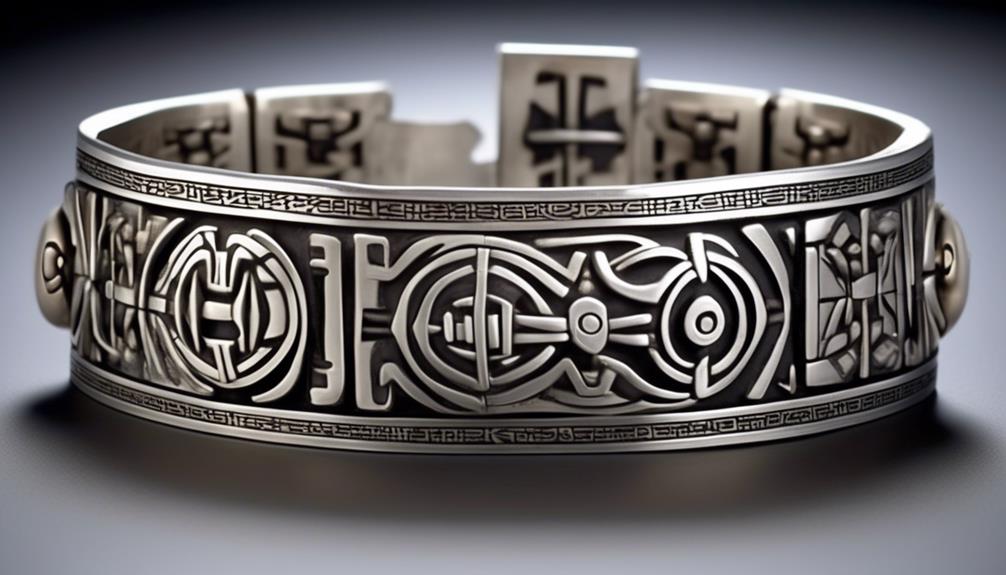
Mastering traditional Hopi jewelry techniques unveils a rich tapestry of cultural motifs and patterns that are deeply intertwined with the tribe's heritage and artistic expressions. The incorporation of meaningful designs and patterns in Hopi jewelry is a reflection of the tribe's cultural significance and artistic legacy.
Here are some key motifs and patterns that hold deep cultural meaning in Hopi Tribe jewelry:
- Kachina: Kachina figures are central to Hopi beliefs and are often depicted in jewelry to symbolize the presence of ancestral spirits and their role in guiding and protecting the tribe.
- Water Symbolism: Water is a precious and sacred element in Hopi culture, and its symbolic representation in jewelry reflects concepts of purity, life, and renewal.
- Migration Patterns: Hopi jewelry often incorporates motifs representing the migration journey of the tribe, highlighting the historical and spiritual significance of their movements across the land.
- Nature and Wildlife: Depictions of animals, plants, and natural elements in jewelry hold deep spiritual and cultural significance, representing the interconnectedness of all living beings in the Hopi worldview.
Finishing and Polishing Your Handcrafted Masterpieces
How do the Hopi artisans bring a radiant finish to their meticulously handcrafted jewelry, honoring their cultural heritage and artistic traditions? The final step in creating Hopi Tribe jewelry involves metal cleaning and stone polishing, which are essential for achieving the exquisite beauty and luster that are characteristic of these masterpieces. The artisans meticulously attend to the finishing and polishing process, ensuring that each piece reflects the utmost craftsmanship and reverence for their cultural legacy.
To achieve the impeccable finish that distinguishes Hopi jewelry, the artisans employ traditional methods for metal cleaning and stone polishing. The metal cleaning process involves delicately removing any residue or oxidation from the metal surfaces, revealing the inherent brilliance of the materials. Stone polishing is an equally meticulous process, where the artisans skillfully enhance the natural luster and color of the stones, bringing out their captivating beauty.
| Metal Cleaning | Stone Polishing |
|---|---|
| Remove residue and oxidation from metal surfaces | Enhance natural luster and color of stones |
| Uncover inherent brilliance of materials | Bring out captivating beauty of stones |
| Employ traditional methods | Meticulously attend to the polishing process |
| Reflect utmost craftsmanship | Revere cultural legacy |
| Achieve impeccable finish | Distinguish Hopi jewelry |
Frequently Asked Questions
Can Non-Hopi Individuals Wear and Create Hopi Tribe Jewelry?
Yes, non-Hopi individuals can wear and create Hopi tribe jewelry, but it's important to do so with cultural sensitivity and respectful appreciation. Cultural appropriation is a concern, so it's important to understand the significance of the jewelry and its designs.
It's appropriate to wear and create Hopi jewelry as long as it's done with respect and understanding of its cultural significance. Acknowledging and honoring the traditions is essential.
What Are Some Common Misconceptions About the Symbolism of Hopi Jewelry?
Symbolism in Hopi jewelry is often misunderstood. Misconceptions arise from the interpretation of the designs and their meanings. Cultural appropriation can lead to misrepresentation of these sacred symbols.
It's important to respect the deep cultural significance of each piece and understand its true symbolism. Learning about the traditions and values behind the jewelry is crucial in avoiding misunderstandings and misinterpretations.
Are There Specific Rules or Guidelines for Incorporating Modern Elements Into Traditional Hopi Jewelry Designs?
Incorporating modern elements into traditional Hopi jewelry designs involves a delicate balance of innovation and cultural respect. It's vital to honor the cultural significance and history while embracing contemporary elements.
This process requires a deep understanding of the traditional designs and a keen eye for how modern elements can enhance, rather than overshadow, the essence of the jewelry.
Respecting traditions while infusing modern touches is a thoughtful and artistic endeavor.
How Do Contemporary Hopi Jewelry Makers Approach the Use of Non-Traditional Materials in Their Designs?
When it comes to contemporary designs, Hopi jewelry makers approach the use of non-traditional materials with great care and consideration. While honoring the cultural significance and traditional techniques, they incorporate modern elements thoughtfully, often seeking to maintain the integrity of the art form.
This approach allows for the creation of innovative pieces that bridge the past and present, reflecting the evolving nature of Hopi jewelry while preserving its rich heritage.
What Are Some Ways to Respectfully Honor the Cultural Significance of Hopi Tribe Jewelry When Creating and Wearing It?
Respectful representation of Hopi tribe jewelry involves understanding its cultural significance and history.
Cultural appreciation is shown through learning about the traditional techniques, materials, and designs used in creating the jewelry.
When wearing it, we honor the craftsmanship and symbolism behind each piece.
Conclusion
As we finish our handcrafted Hopi jewelry, we're reminded of the intricate connections between our designs and the rich cultural heritage of the Hopi tribe. Like the delicate patterns etched into silver, our creations reflect the enduring spirit and resilience of the Hopi people.
Each piece tells a story, carrying with it the echoes of generations past and the hopes for generations to come. Our jewelry is more than just adornment; it's a living art form, a testament to the enduring legacy of the Hopi tribe.
Mary is a passionate writer who brings creativity and a fresh perspective to our team. Her words have the power to captivate and inspire, making her an essential contributor to our content. Mary’s commitment to storytelling and dedication to promoting Indigenous culture ensures that her work touches the hearts of our readers. We’re fortunate to have her as part of our team.
